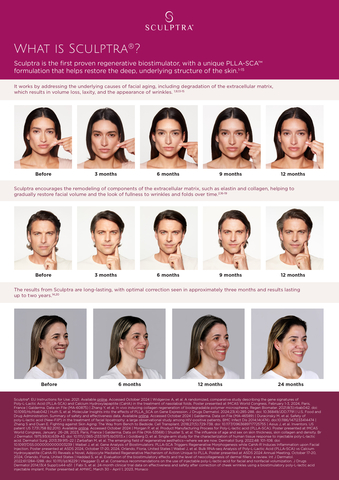Galderma is celebrating the 25th anniversary of the approval of Sculptra, its biostimulating poly-L-lactic acid (PLLA-SCA)-based filler, with new research on its regenerative effects and a nod in China.
Recent gene expression data from a head-to-head study presented at the American Society for Dermatologic Surgery (ASDS) 2024 Annual Meeting showed that Sculptra stimulated more components of the extracellular matrix, including collagen and elastin, while inducing less inflammation, when compared with another biostimulator. Sculptra stimulated 16 pathways related to tissue remodeling and four related to collagen formation, compared to 10 and three, respectively, for the comparator biostimulator, the study showed.
Additional data presented at the ASDS 2024 Annual Meeting highlighted Sculptra’s potential positive effect on adipocyte modulation, which might explain its clinical benefits in skin quality such as increased skin glow, improved facial fat function and structure, and reduced signs of facial aging. The data showed that treatment with Sculptra resulted in upregulation of 13 genes associated with anti-inflammatory effects and adipocyte modulation.
This was reinforced by two new studies published this year in the Journal of Drugs in Dermatology, which provided supportive as well as deeper insights into the regenerative effects of Sculptra. The studies found that Sculptra significantly reduced the severity of moderate or severe cheek wrinkles while improving skin quality, with results lasting across the 12-month study period. The responder rate was significantly higher for Sculptra versus the no-treatment control at seven months (66.2% and 38.6%), nine months (70.6% and 31.1%) and 12 months (71.6% and 26.1%). Moreover, Sculptra maintained high patient satisfaction, with over 84% of patients reporting natural-looking results and expressing interest in repeat treatments to correct cheek wrinkles.
“Sculptra has fundamentally changed the landscape of facial rejuvenation and has had a significant impact on my practice,” says Alessandra Haddad, MD, PhD, an Affiliate Professor at Plastic Surgery Department, Chief of Skin Care and Laser Section at Federal University of Sao Paulo in Brazil.“Additionally, Sculptra helps to restore patients’ youthful appearance and improve skin quality, while looking and feeling natural – and my patients’ satisfaction is evident in their continued attendance at yearly maintenance sessions. This, coupled with the extensive body of evidence on Sculptra’s efficacy and safety, positions Sculptra as a leading choice for practitioners.”
Sculptra was first launched and approved in the European Union as a volume replenishment treatment in 1999 to correct the facial wasting experienced by AIDS patients. Over the years, it has evolved into a versatile treatment with a range of applications beyond volumization, which can include skin firmness, structural support, radiance, and overall skin quality, with results lasting for over two years
Recent research shows that, in addition to collagen, Sculptra’s PLLA-SCA formulation also has a stimulatory effect on key components of the extracellular matrix, such as elastin, proteoglycans and multi-adhesive glycoproteins, and agents which activate the remodeling of adipose (fat) tissue, making it the first proven regenerative biostimulator.
Sculptra is approved by multiple regulatory authorities, most recently in China.


